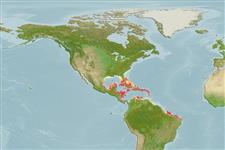Environment: milieu / climate zone / depth range / distribution range
पारिस्थितिकी
समुद्री प्रवाल-भित्ति संयुक्त; गहराई सीमा 3 - 45 m (Ref. 9710), usually 3 - 17 m (Ref. 9761). Tropical
Western Central Atlantic: Haiti, Bahamas, Jamaica, Cayman Islands, Florida (USA) and continental western Caribbean. Absent in Puerto Rico, Virgin Islands, and the Lesser Antilles.
आकार / वज़न / Age
Maturity: Lm ? range ? - ? cm
Max length : 14.3 cm TL पुल्लिंग / अलिंग; (Ref. 5521)
About 5 deep blue bars of uneven width; second bar, below dorsal fin, much wider than others (Ref. 26938).
A solitary species (Ref. 26340) inhabiting coral reefs (Ref. 9710).
Life cycle and mating behavior
Maturities | पुनरुत्पत्ति | Spawnings | Egg(s) | Fecundities | लार्वा
Domeier, M.L., 1994. Speciation in the serranid fish Hypoplectrus. Bull. Mar. Sci. 54(1):103-141. (Ref. 26407)
IUCN Red List Status (Ref. 130435)
Threat to humans
Harmless
Human uses
मात्स्यिकी: व्यापारिक; जलजीवालय: व्यापारिक
साधन
Special reports
Download XML
इंटरनेट स्रोत
Estimates based on models
Preferred temperature (Ref.
123201): 26.4 - 28.2, mean 27.5 °C (based on 585 cells).
Phylogenetic diversity index (Ref.
82804): PD
50 = 0.5000 [Uniqueness, from 0.5 = low to 2.0 = high].
Bayesian length-weight: a=0.01778 (0.00680 - 0.04650), b=3.03 (2.80 - 3.26), in cm total length, based on LWR estimates for this (Sub)family-body shape (Ref.
93245).
Trophic level (Ref.
69278): 3.9 ±0.4 se; based on size and trophs of closest relatives
लौटाव (Ref.
120179): माध्यम, न्यूनतम जनसंख्या दुगनी होने का समय 1.4 - 4.4 वर्ष। (Preliminary K or Fecundity.).
Fishing Vulnerability (Ref.
59153): Low vulnerability (10 of 100).
Nutrients (Ref.
124155): Calcium = 76.7 [43.1, 153.6] mg/100g; Iron = 0.656 [0.355, 1.241] mg/100g; Protein = 18 [16, 20] %; Omega3 = 0.135 [0.080, 0.225] g/100g; Selenium = 27.6 [15.3, 55.0] μg/100g; VitaminA = 91.6 [24.2, 399.4] μg/100g; Zinc = 1.3 [0.8, 2.0] mg/100g (wet weight);
